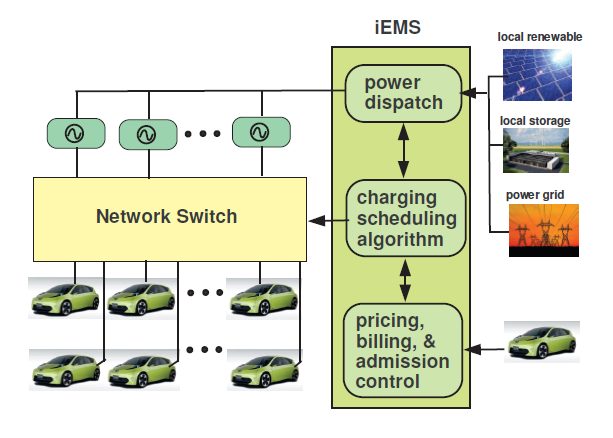Large scale charging at public facilities
In this section, we present the framework of EV charging in public charging facilities. In US, there are several major parties that invest in public EV charging stations. The government spends in charging stations in public facilities such as hospitals and schools due to the environmental consideration. The business runners of grocery stores and shopping malls build charging stations near their business to attract customers for the primary business, provide a bonus service for employees, and boost the sustainability credentials. The major national operators of charging stations, such as ChargePoint and eVgo, invest in charging service targeting the rapid growing EV market. The manufactories of EVs build charging stations to boost the market share of their products and provide after sale services to loyal consumers.
The placement of charging facilities affects the favorability of each station. Factors that influence this may include but are not limited to variations in accessibility and availability of service other than charging, e.g., tyre inflator and mini market. Accessibility refers to how easy it is for consumers to access the charging station and potentially affects the volume of the passenger flow. A similar discussion is presented for gas stations by Salopavailable renewable in the future.and Hotelling. For example, a site at a workplace parking lot may be more attractive than a location that is less frequently visited by consumers. Ancillary services refer to other services that a charging station may provide such as vehicle repair and supermarkets. Kroger, the largest grocery store owner of the U.S., has installed over 300 Level 2 and DC fast charging stations in the major markets over the country. Walmart and Kohl’s also expanded their charging stations.
These public charging station locations are also favored by EV owners since they can charge while shopping. The intelligent energy management system (iEMS) architecture for public charging stations is illustrated in Figure 8. The scheduler here is the owner or the operator of the charging facilities, it is natural to consider centralized con-

Figure 8: Architecture for network switched charging and iEMS.
trol. The hardware system of the proposed iEMS includes a dispatcher that delivers power from a mix of energy sources–local energy (e.g., renewable energy and local storage) and purchased electricity from the grid–to tens or hundreds of chargers. By sending out the control signal, the scheduler activates and deactivates the chargers connected to EVs admitted to the facility to serve more urgent or more profitable requests.
The iEMS is run by the software system that makes engineering and economic decisions. At the core of the software system for the iEMS is the charge scheduling algorithm, which is the focus of this monograph. The scheduler (i) sets the connections of the switch so that a subset of EVs are charged by the available chargers, and (ii) determines the admission of new EVs based on its charging demand and the system operating condition. The software system also has to handle billing, other ancillary services and possibly the forecast of available renewable in the future.

